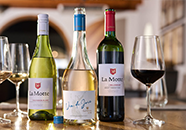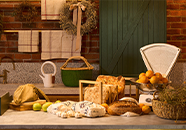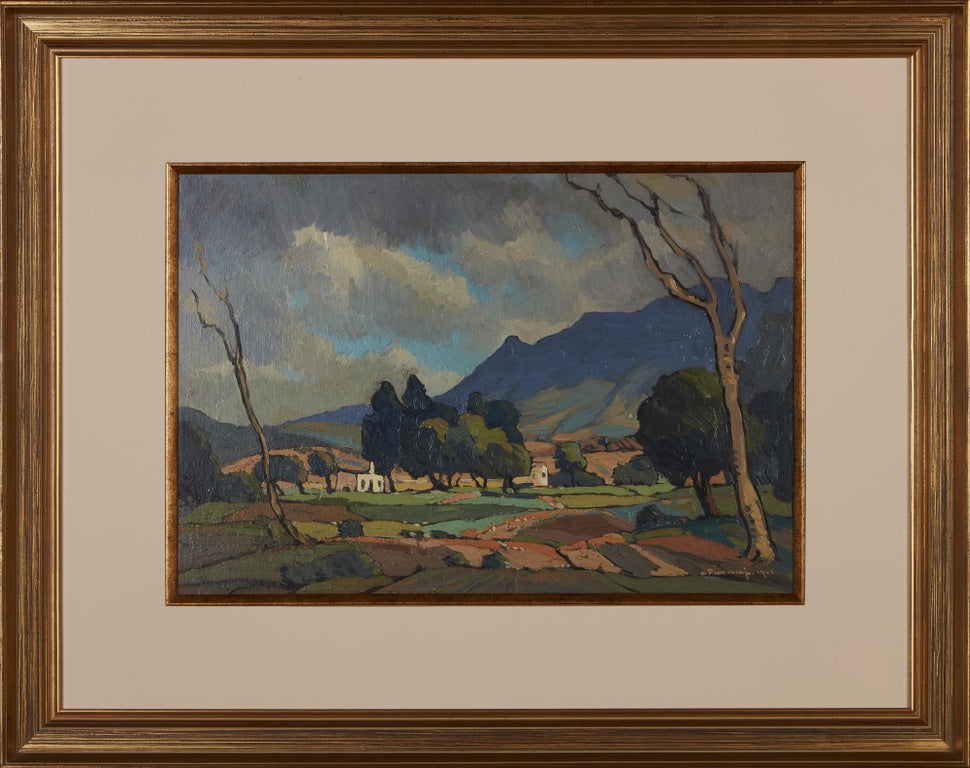Pierneef en die Kaap / Pierneef and the Cape
Pierneef het die Kaap vermoedelik die eerste keer in 1916 saam met Erich Mayer besoek om na oorspronklike tekeninge van San-rotskuns deur geoloog en etnoloog George Stow te gaan kyk — die tekeninge was in daardie stadium in Dorothea Bleek se besit. Vandag vorm ‘n gedeelte van die Stow-argief deel van die IZIKO-versameling. Pierneef het die Kaap daarna weer in Julie 1918 besoek om ’n opdragwerk ten opsigte van Kaapse tonele vir Lady Buxton uit te voer.
By nadere ondersoek van die onderwerpe wat Pierneef verken het, dateer die meeste van sy Kaapse tonele uit 1921, die jaar waarin Pierneef sy eerste solo-uitstallings in die Kaap aangebied het. Die eerste hiervan was van 9 tot 13 April, op Stellenbosch by Die Uitspan, met 105 kunswerke in olie, waterverf en pastel, sowel as etse, linosneë en sketse. Die dekorpanele wat Pierneef en Mayer vir J F W Grosskopf se verhoogstuk ’n Esau geskilder het, was ’n hoogtepunt van dié uitstalling. Die tweede uitstalling is by Ashbeys Gallerye in Langstraat, Kaapstad gehou, waar Pierneef meer as 86 kunswerke vertoon het en waartydens hy by Grosskopf op Stellenbosch gebly het. Grosskopf het ook die eerste publikasie oor Pierneef, J H Pierneef – Die man en sy werk, in 1946 geskryf. J L van Schaik het dit ’n jaar later ook in Engels uitgegee.
Pierneef het ’n besonderse belangstelling in die Kaap se bergformasies en -massas sowel as die Kaaps-Hollandse boustyl gehad. Die berge is meestal in pers en blou tone voorgestel. Simonsberg en die Tweelingpieke oorheers Pierneef se Kaapse tonele en word veral in die mediums linosnee en skilder aangetref. Onder die prominente Kaaps-Hollandse opstalle wat Pierneef as onderwerp gebruik het, was daar straattonele en gewelhuise van Tulbagh en Stellenbosch wat veral wyd verken en uitgebeeld is. Te oordeel na sy kunswerke was die naaste wat Pierneef aan Franschhoek gekom het sy uitbeelding van L’Ormarins. Dié waterverfwerk, wat in 1952 op L’Ormarins geskilder is, is te sien in James Walton se publikasie Homesteads and Villages of South Africa, wat in 1952 uitgegee is, ook deur J L van Schaik.
Met die uitvoer van sy bekendste en mees ikoniese openbare opdrag, die Johannesburg Stasiepanele, het Pierneef die Kaap in vyf van die 28 landskaptonele gebruik, wat op die dominansie en belang van die Kaap in die Suid-Afrikaanse landskap dui. Hierdie tonele sluit in Hermanushawe, Tafelberg, Leeukop, Stellenbosch (met die Tweelingpieke) en die Knysna-koppe. Die Kaap is wéér in 1933/34 in die panele vir die openbare opdrag t.o.v. die Suid-Afrika-huis in Londen gebruik. Hier het Pierneef die landskap van die Constantiavallei met die berge van Constantianek as onderwerp gebruik. ’n Skildery wat met dié paneel ooreenstem, is te sien in die oorspronklike opstal op Vergelegen Wynlandgoed.
J H Pierneef is believed to have first visited the Cape with Erich Mayer in 1916, on a trip to see the original tracings of San rock art by geologist and ethnologist George Stow. At the time, these tracings were in the possession of Dorothea Bleek. Today, a selection of the Stow archive forms part of the IZIKO collection. Pierneef visited the Cape again in July 1918, to carry out a commission entailing Cape scenes for Lady Buxton.
A closer inspection of the subjects Pierneef explored, showed that most of his Cape scenes dated from 1921, the year he held his first solo exhibitions in the Cape. The first exhibition was held in Stellenbosch at Die Uitspan, from 9 to 13 April, with 105 artworks in oil, watercolour and pastel, as well as etches, linocuts and drawings. The décor panels that Pierneef and Mayer had done for J F W Grosskopf’s play, ’n Esau, were a highlight at this exhibition. The second exhibition was held at Ashbeys Galleries in Long Street, Cape Town, with over 86 artworks on display during which time Pierneef stayed with Grosskopf, who lived in Stellenbosch. Grosskopf also authored the first publication on Pierneef, JH Pierneef – Die man en sy werk (1946). A year later, J L van Schaik also published an English version thereof.
Pierneef had a special interest in the Cape’s mountain formations and masses, typically executed in purple and blue tones, as well as Cape Dutch architecture. Simonsberg and the Twin Peaks dominate Pierneef’s Cape scenes, rendered mostly in the mediums of linocut and painting. With regard to the prominent Cape Dutch homesteads that served as subjects in Pierneef’s work, the street scenes and gabled houses of Tulbagh and Stellenbosch were particularly widely explored and depicted. Judging by his artworks, the closest Pierneef got to Franschhoek was his portryal of L’Ormarins. This water-colour, done at L’Ormarins in 1952, appears on the cover of James Walton’s Homesteads and Villages of South Africa, published in 1952, also by J L van Schaik.
In his best-known and most iconic public commission, the Johannesburg Station panels, Pierneef depicted the Cape in five of the 28 landscape scenes, indicating the dominance and importance of the Cape within the South African landscape. The scenes include Hermanus harbour, Table Mountain, Lion’s Head, Stellenbosch (with the Twin Peaks) and the Knysna Heads. The Cape featured, once again, in the panels for the public commission regarding the South Africa House in London, in 1933/34. This time, Pierneef chose the landscape of the Constantia Valley with the Constantia Nek mountains as his subject. A painting similar to this panel can be seen in the original homestead at Vergelegen Wine Estate.
Bronne / Sources
Nel, P G (eds). 1990. J H Pierneef: His life and his work. p50, 56-58.
Die Huisgenoot. 1934. 1 Junie. p36.
Duffey, AE. 2002. Pierneef and San Rock art. De Arte 66:20-41.
Versameling / Collections
Johannesburgse Stasiepanele / Johannesburg Station Panels – TRANSNET. Uitstalling / Exhibition: Rupert Museum, Stellenbosch.
Kaapse tonele / Cape scenes;
Pretoriase Kunsmuseum / Pretoria Art Museum; DITSONG Kultuurhistoriese Museum / Cultural History Museum, Pretoria; Pretoria Universiteit / University; IZIKO Museums – Suid-Afrikaanse Nasionale Galery, Kaapstad / South African National Gallery, Cape Town; La Motte Wynlandgoed / Wine Estate – Linosneë / Linocuts.

















